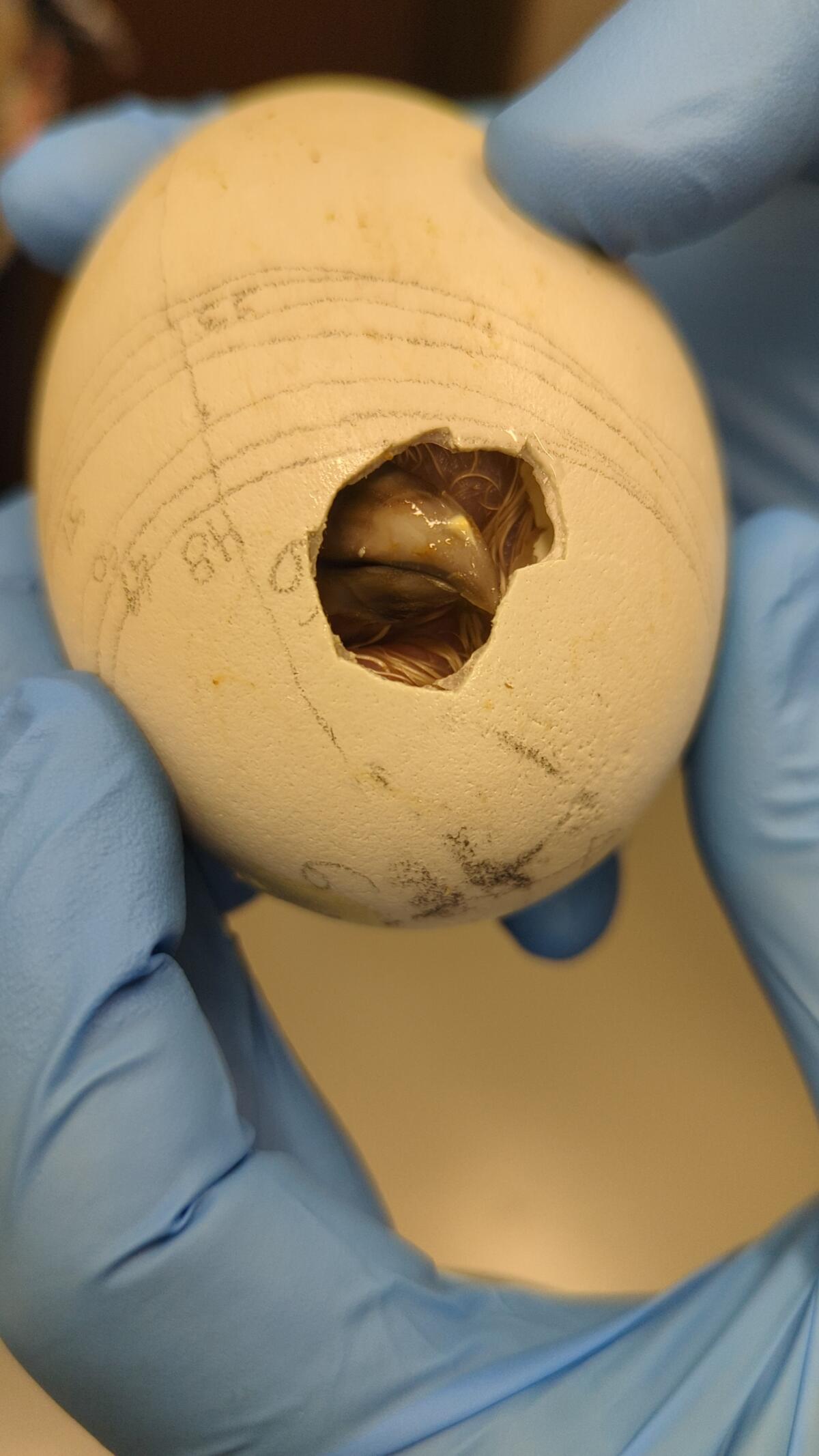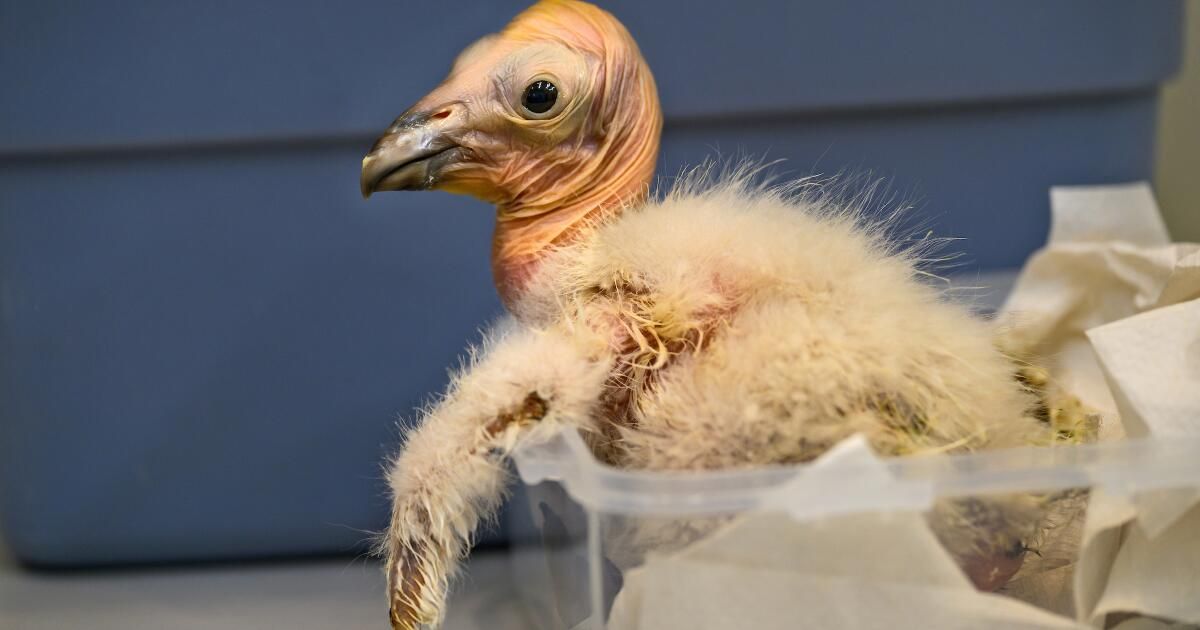A new method of breeding California condors at the Los Angeles Zoo has resulted in a record 17 chicks hatched this year, the zoo announced Wednesday.
A zoo spokesman said all of the newborn birds will eventually be considered for release into the wild under the U.S. Fish and Wildlife Service's California Condor Recovery Program.
“What we are seeing now are the benefits of the new breeding and reproduction techniques developed and implemented by our team,” zoo curator of birds Rose Legato said in a statement. “The result is more condor chicks in the program and, ultimately, more condors in the wild.”
Breeding pairs of California condors live at the zoo in structures that staff “affectionately refer to as condor-miniums,” said spokesman Carl Myers. When a female produces a fertilized egg, the egg is moved to an incubator. As the hatch date approaches, the egg is placed with a surrogate parent capable of raising the chick.
The eggs of the California condor are kept at the Los Angeles Zoo. The animal is in serious danger of extinction.
(Jamie Pham / Los Angeles Zoo)
This extraordinary year of condor breeding is the result of a modification in a breeding technique. He was a pioneer at the Los Angeles Zoo.
Previously, when the zoo found itself with more fertilized eggs than available adult substitutes, staff would hand-raise the young birds. But condors raised by human caretakers have a lower chance of survival in the wild (hence the condor puppets (used by zookeepers in the 1980s to prevent young birds from becoming impregnated by their human caretakers).
In 2017, the Los Angeles Zoo experimented with giving an adult bird named Anyapa two eggs instead of one. The gamble was a success. Both birds were successfully released into the wild.
With so many eggs this year, “the keepers thought, ‘Let’s try three,’” Myers said. “And it worked.”
The zoo's mentor condors managed to raise three single chicks, eight chicks in double broods and six chicks in triple broods this season. The previous record of 15 chicks had been set in 1997.
Condor experts welcomed the new strategy.
“Condors are social animals, and we learn more about their social dynamics every year. So I’m not surprised that these chick-rearing techniques are working,” said Jonathan C. Hall, a wildlife ecologist at Eastern Michigan University. “I would expect chicks raised this way to do well in the wild.”
The California condor, North America's largest land bird with an impressive wingspan of up to 2.8 meters, could once be found across the continent. Its population began to decline in the 19th century, when settlers with modern weapons moved into the birds' territory. This scavenger species was hunted by humans and inadvertently poisoned by lead bullet fragments embedded in the carcasses it ate. The federal government classified these birds as an endangered species in 1967.

A condor, one of 17 specimens at the zoo, breaks records and comes out of its shell.
(Jamie Pham / Los Angeles Zoo)
When the California Condor Recovery Program began four decades ago, there were only 22 California condors left on Earth. As of December, there were 561 individuals alive, of which 344 were in the wild. Despite the program's success in increasing the population, the species is still alive. Critically endangered.
In addition to the constant threat of lead poisoning, large birds are also at risk of being exposed to other toxins. A 2022 study found that more than 40 compounds related to DDT in the blood of wild California condors: chemicals that had made their way from contaminated marine life to the top of the food chain.
“Despite our success in returning condors to the wild, free-flying condors continue to face many challenges, with lead poisoning being the leading cause of mortality,” said Joanna Gilkeson, spokeswoman for Fish and Wildlife’s Pacific Southwest Region. “Innovative strategies, like those being implemented by the Los Angeles Zoo, help us produce more healthy chicks and continue releasing condors into the wild.”
The chicks will remain in the zoo's care for the next year and a half before being evaluated for possible release into the wild. So far, the zoo has contributed 250 condor chicks to the Fish and Wildlife program, some of which the agency has redistributed to other zoos as part of its conservation efforts.
in a Article published earlier this yearA team of researchers found that birds born in captivity have slightly lower survival rates during the first year or two, but then do equally well as birds born in the wild.
“Since condors reproduce slowly, releasing captive-bred birds is essential to the species’ recovery, especially in light of ongoing losses due to lead-related mortality,” said Victoria Bakker, a quantitative ecologist at Montana State University and lead author of the paper. “The Los Angeles Zoo team should be recognized for their innovative and important contributions to condor recovery.”












